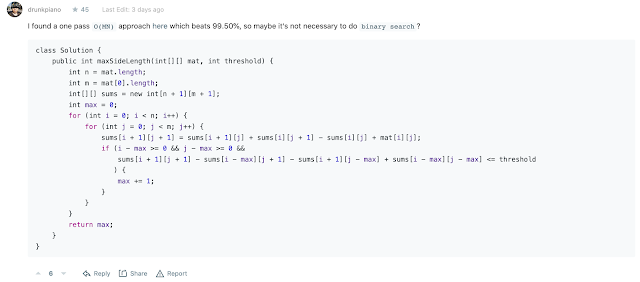Problem Statement
Given a m x n matrix mat and an integer threshold. Return the maximum side-length of a square with a sum less than or equal to threshold or return 0 if there is no such square.
Example 1:

Input: mat = [[1,1,3,2,4,3,2],[1,1,3,2,4,3,2],[1,1,3,2,4,3,2]], threshold = 4
Output: 2
Explanation: The maximum side length of square with sum less than 4 is 2 as shown.
Example 2:
Input: mat = [[2,2,2,2,2],[2,2,2,2,2],[2,2,2,2,2],[2,2,2,2,2],[2,2,2,2,2]], threshold = 1
Output: 0
Example 3:
Input: mat = [[1,1,1,1],[1,0,0,0],[1,0,0,0],[1,0,0,0]], threshold = 6
Output: 3
Example 4:
Input: mat = [[18,70],[61,1],[25,85],[14,40],[11,96],[97,96],[63,45]], threshold = 40184
Output: 2
Constraints:
1 <= m, n <= 300m == mat.lengthn == mat[i].length0 <= mat[i][j] <= 100000 <= threshold <= 10^5
Problem link
Video Tutorial
You can find the detailed video tutorial here
Thought Process
There is an absolute brute force way is to calculate the sum of each square in every iteration. There are previous similar problems that we can have a prefix sum matrix, similar to the rolling sum idea on one dimensional array.
A prefix sum matrix is a matrix that for each cell[i, j] represents the sum in original matrix from matrix[0, 0] to matrix [i, j] (inclusive)
The advantage is later we can get any rectangle sum simply performing below
sum from [i, j] to [i + len][j + len] = prefixSum[i + len][j + len] - prefixSum[i - 1][j + len] - prefixSum[i + len][j - 1] + prefixSum[i - 1][j - 1]
Two more optimizations we can do
- We can apply binary search instead of a linear one to find the max length
- We can also keep a record of the sum while building up the prefix sum matrix. The reason this works is if it has a square say 3x3 that meets the requirement, then it would definitely have a square 2x2 meet the requirement. So we can start from 1x1, 2x2 till we reach the max. Pretty smart! Kudos to @drunkpiano
- Reference is here: Leetcode discussion solution with binary search and smart solution
Solutions
1 public int maxSideLength(int[][] mat, int threshold) { 2 if (mat == null || mat.length == 0 || mat[0].length == 0) { 3 return 0; 4 } 5 int row = mat.length; 6 int col = mat[0].length; 7 // easier to implement with the initial value on the boarder to be 0 8 int[][] prefixSum = new int[row + 1][col + 1]; 9 10 // the idea of using a prefix sum matrix should be a common technique, each cell contains the sum of 11 // its top left sum, including itself 12 for (int i = 1; i <= row; i++) { 13 for (int j = 1; j <= col; j++) { 14 prefixSum[i][j] = prefixSum[i - 1][j] + prefixSum[i][j - 1] - prefixSum[i - 1][j - 1] + mat[i - 1][j - 1]; // needs to plus itself as well 15 } 16 } 17 18 // brute force way to start from max length O(M*N*min(M, N))= O(N^3) 19 // could use binary search to find the first element 20 // https://leetcode.com/problems/maximum-side-length-of-a-square-with-sum-less-than-or-equal-to-threshold/discuss/451871/Java-sum%2Bbinary-O(m*n*log(min(mn)))-or-sum%2Bsliding-window-O(m*n) 21 for (int len = Math.min(row, col); len >= 1; len--) { 22 for (int i = 1; i + len <= row; i++) { 23 for (int j = 1; j + len <= col; j++) { 24 if (prefixSum[i + len][j + len] - prefixSum[i - 1][j + len] - prefixSum[i + len][j - 1] + prefixSum[i - 1][j - 1] <= threshold) { 25 return len + 1; 26 } 27 } 28 } 29 } 30 31 return 0; 32 }
Prefix sum implementation
Time Complexity: O(M*N*min(M,N)) where M is row N is col, essentially O(N^3)
Space Complexity: O(M*N) since we need
References

